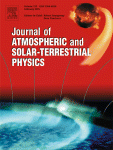
 A new IRO retrieval method is developed, using electron density gradient information of reconstructed ancillary model.
A new IRO retrieval method is developed, using electron density gradient information of reconstructed ancillary model.
The new electron density retrieval approach is based on model reconstructed from inversed profiles.
•The inversion results from the simulated data show that the new retrieval method is more effective.
The classical inversion of Global Positioning System (GPS) Ionospheric Radio Occultation (IRO) data is Abel inversion method, in which the spherical symmetry of the ionospheric electron density distribution is assumed. This assumption can cause some errors for the inversion of IRO data. In this paper, the error characteristics are discussed and a new IRO retrieval method is developed, which uses electron density gradient information of reconstructed ancillary model derived from classic Abel inversion to correct Total Electron Content (TEC) and then combines the corrected TEC with the spherical symmetric Abel inversion method. The inversion results from the simulated data of the Constellation Observing System for Meteorology, Ionosphere and Climate (COSMIC) IRO are compared with reference profiles by directly interpolation, and show that the new retrieval method is more effective.
Keywords
- Ionospheric Radio Occultation;
- Ionospheric electron density;
- Total Electron Content
YOU MIGHT ALSO LIKE












